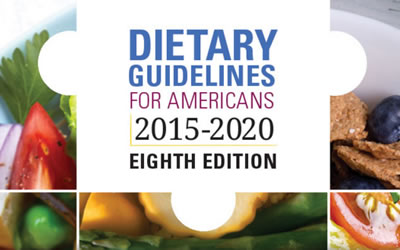2015-2020 U.S. Dietary Guidelines | The Pritikin Perspective
While it’s true that the newly released 2015-2020 U.S. Dietary Guidelines no longer advise Americans to limit dietary cholesterol to less than 300 milligrams a day, the new guidelines do not suggest that Americans can eat all the eggs they want. (Egg yolks are a super-rich source of dietary cholesterol. One large yolk has 184 milligrams.) Rather, the new guidelines advise Americans to keep their intake of dietary cholesterol as low as possible.

2015-2020 U.S. Dietary Guidelines
Dietary Cholesterol
While it’s true that the newly released 2015-2020 U.S. Dietary Guidelines no longer advise Americans to limit dietary cholesterol to less than 300 milligrams a day, the new guidelines do not suggest that Americans can eat all the eggs they want. (Egg yolks are a super-rich source of dietary cholesterol. One large yolk has 184 milligrams.)
Rather, the new guidelines advise Americans to keep their intake of dietary cholesterol as low as possible.
“… eat as little dietary cholesterol as possible”
Here is the exact wording of the 2015-2020 U.S. Dietary Guidelines:
“Key Recommendation from the 2010 Dietary Guidelines to limit consumption of dietary cholesterol to 300 mg per day is not included in the 2015 edition, but this change does not suggest that dietary cholesterol is no longer important to consider when building healthy eating patterns. As recommended by the IOM [Institute of Medicine], individuals should eat as little dietary cholesterol as possible while consuming a healthy eating pattern.”

Headlines like “Go ahead and have eggs” will only add to the confusion regarding nutrition research and what it shows most Americans should eat to reduce their risk of diet-promoted diseases like obesity, heart disease, diabetes, and hypertension.
It will be up to responsible health professionals and especially registered dietitians to help their clients better understand what foods and food components they need to limit or include to improve their health and weight-loss efforts.
Arguably, the guideline’s dropping of the 300 mg daily limit on dietary cholesterol was a step in the wrong direction. Dropping this limit was a big win for the meat, dairy, and especially egg industry.
More Facts About Dietary Cholesterol
Long ago, multiple randomized controlled trials demonstrated that total cholesterol, LDL cholesterol, and non-HDL blood cholesterol levels all increase as consumption of dietary cholesterol increases from 0 to 300 mg daily. Blood cholesterol levels increase even more as intake of dietary cholesterol increases above 300 mg a day.
Moreover, strong data, including that from numerous randomized controlled trials, have shown that eating patterns that reduce both dietary cholesterol and saturated fat reduce levels of cholesterol-rich, artery-clogging, apoB-containing lipoproteins, which are best reflected by looking at non-HDL cholesterol levels.
Here are more highlights of the 2015-2020 U.S. Dietary Guidelines…
2015-2020 U.S. Dietary Guidelines
Added Sugar
For the first time, the U.S. Dietary Guidelines took on the Sugar Association and put a specific limit on the use of added sugars.
They recommended that added sugars make up less than 10% of Americans’ total calorie intake. For an adult, that generally means no more than 12 teaspoons a day, which is the same amount that’s in one can of Coke.
The guidelines also specified that this limit on sugar excludes naturally-occurring sugars, like those found in nonfat (skim) milk or whole fruits.
2015-2020 U.S. Dietary Guidelines
Overall Healthy Dietary Pattern
“And the key recommendations’ unqualified reference to cheese is puzzling,” continues Dr. Rifai.
“The internal details of the guidelines do discuss that cheese generally adds calories, saturated fat, and sodium compared to healthy forms of dairy like skim milk and fat- and sugar-free yogurts. But people tend to look only at the key recommendations, which imply that hard cheeses are healthy. They usually are not.”
Another clarification in the key guidelines that would have been highly beneficial to the American people is recommending egg whites, not whole eggs.
And let’s not get too complacent about fat intake.
The fact is, nothing is more calorie dense than pure fats and oils. However, when past guidelines ignored calorie density and nutrient density and focused mainly on modestly reducing percentage of fat calories consumed, the result was the commercial food industry churning out numerous “fat-free” and “low-fat” cookies, cakes, chips, donuts, and other calorie-dense, nutrient-poor foods. Hence, we are now seeing a growing emphasis on promoting overall diet quality rather than simply setting unproductive limits on specific dietary factors.
2015-2020 U.S. Dietary Guidelines
Coffee
2015-2020 U.S. Dietary Guidelines
Sodium
The 2015-2020 U.S. Dietary Guidelines recommend a limit of 2,300 milligrams of sodium a day for the general population and a 1,500 mg limit for Americans with prehypertension and hypertension.
But keep in mind that fully two-thirds of the adult American population has prehypertension or hypertension, so the great majority of the U.S. population should in fact be striving for a daily limit of 1,500 mg of sodium.
Here is the exact wording in the new guidelines regarding sodium intake:
“Adults with prehypertension and hypertension would particularly benefit from blood pressure lowering. For these individuals, further reduction to 1,500 mg per day can result in even greater blood pressure reduction. Because of the linear dose-response relationship between sodium intake and blood pressure, every incremental decrease in sodium intake that moves toward recommended limits is encouraged. Even without reaching the limits for sodium intake, strong evidence indicates that reductions in sodium intake can lower blood pressure among people with prehypertension and hypertension. Further, strong evidence has demonstrated that adults who would benefit from blood pressure lowering should combine the Dietary Approaches to Stop Hypertension (DASH) dietary pattern with lower sodium intake.”
The Pritikin Eating Plan is very similar to DASH.
And like the Pritikin Eating Plan, the American Heart Association advises all Americans to limit sodium to no more than 1,500 mg per day.
2015-2020 U.S. Dietary Guidelines
Meat
The new guidelines recommend we choose lean meats and poultry, and it notes that eating less meat, including processed meat and processed poultry, has been linked to a lower risk of heart disease.
But the guidelines do not offer any specific limits on the amount of red and processed meats. Instead, they state that processed meats and processed poultry are okay as long as their intake is not sufficient to cause the overall diet to exceed the limits for sodium (less than 2,300 mg per day) and saturated fats (less than 10% of calories per day).
However, “by omitting specific diet recommendations… these guidelines miss a critical and significant opportunity to reduce suffering and death from cancer,” stated Richard Wender, MD, chief cancer control officer for the American Cancer Society.
Not surprisingly, the National Cattlemen’s Beef Association praised the new U.S. Dietary Guidelines
The nonprofit consumer advocacy association, the Center for Science in the Public Interest, pointed out that the new guidelines do advise Americans to eat less meat, suggesting that the U.S. Department of Agriculture and Health and Human Services Departments at least “partially resisted the political pressure.”
David Katz, MD, Founder Director of Yale University Prevention Research Center, was less forgiving, stating that the new guidelines “represent a disgraceful replacement of specific guidance with the vaguest possible language.”
2015-2020 U.S. Dietary Guidelines | Bottom Line
While not perfect, the 2015-2020 U.S. Dietary Guidelines overall deserve praise.
Michael Jacobson, PhD, Founder and Executive Director of the Center for Science In the Public Interest, agrees:
“If Americans ate according to [the guidelines’ advice], it would be a huge win for the public’s health. That said, the federal government’s basic nutrition advice has remained largely unchanged for the past 35 years. The problem is that the food industry has continued to pressure and tempt us to eat a diet of burgers, pizzas, burritos, cookies, doughnuts, sodas, shakes, and other foods loaded with white flour, red and processed meat, salt, saturated fat, and added sugars, and not enough vegetables, fruit, and whole grains.”